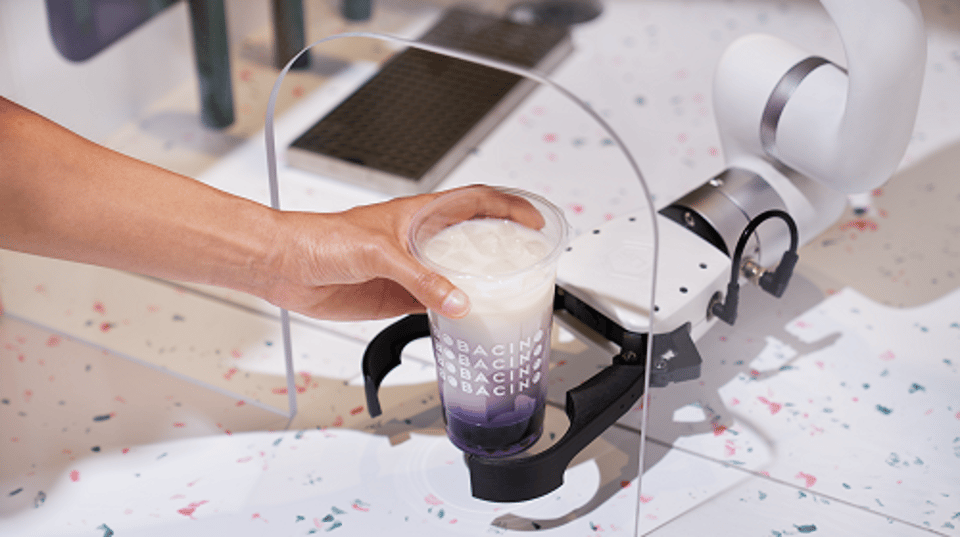Automated Beverage Kiosk to Integrate Facial Recognition Payment Tech
Startup Bobacino is partnering with PopID to offer guests a fast and secure way to pay for their bubble tea at automated tea shops.
Contactless transactions are here to stay, and demand for low-touch, easily accessible beverage options remains high; the partnership will offer consumers the ability to pay with their face at the beverage retailer’s automated boba locations and on mobile devices.
Bobacino is still in the prototype phase and plans to launch in the first half of 2022.
The concept: a standalone, fully integrated beverage system and dispenser that combines futuristic technology with a range of diverse flavors and customizable ingredients for an automated bubble tea experience. PopID’s advanced facial recognition technology complements Bobacino’s low-touch automation, speed and access expectations for consumers.
Bobacino is backed by venture capital funds Wavemaker Partners and and Embark Ventures, and Wavemaker Labs, an automation-focused venture studio. The company features a seasoned team of robotics and food experts made up of executives and founders from Miso Robotics, SpaceX and Microsoft.
HT caught up with Darian Ahler, CEO of Bobacino, about this exciting new concept that combines robotics, automation and facial recognition with an on-trend tea-based beverages.
Bobacino's Automated Tea Retail Concept
- On-site contactless ordering and payment: PopID-compatible Bobacino machines will feature full software and hardware integration, allowing customers to select and utilize PopID’s PopPay solution as a payment method on the same screen they viewed Bobacino’s menu and placed their order. Customers can still pay via traditional credit/debit cards if they do not have a PopID account.
- App ordering and payment: Bobacino customers will be able to use PopID as a payment method on PopID’s app for placing pre-orders for pickup.
- Customer confirmation: Customers will also have the option of verifying their identity with PopID to retrieve their order. Through an opt-in only system, the customer’s face will be scanned and authenticated to dispense the drink. No customer data will be saved on Bobacino machines.
- ‘Powered by Bobacino’ integration: For operators that choose to deploy their own branded Bobacino machines, they will have the option to integrate PopID into their automated boba tea bars.
HT: How did this concept come about?
Darian Ahler, CEO of Bobacino: Bobacino was created with the idea of bringing the unique boba tea experience to a larger audience. When I first came across boba it was super eye opening – it was a drink that was more than just a drink. It was an event! Friends would go get boba together, and it was this shared experience. I just loved that.
There is an expanding audience of boba lovers and new enthusiasts out there. And I wanted to bring boba to that audience and create more of those memorable experiences through a fully automated boba bar capable of giving this time-honored tradition more customizable ingredients.
I wanted to fuse AI, robotics and a range of diverse flavors, to create fresh, new memories for customers. Robots are something that already attract and fascinate people, and it just helps to open up the idea of trying something new because a robot is making it right in front of you ... And in today’s world, contactless solutions/creations are certain to make this that much more appealing; consumers want to know they are drinking something that has gone through minimal exposure to contaminants before it gets to them.
HT: What role will automation play at Boba Tea?
Ahler: Like other areas in the food and restaurant industry, boba ship operators are facing a series of challenges that are impacting their ability to grow and expand. Examples of this are the critical labor shortage that is adversely affecting restaurant operations and bottom lines, and the high costs of opening a physical location. This is also in addition to the sudden shift in customer behavior, which is increasingly looking for safe, low-touch experiences amid the ongoing COVID-19 pandemic.
[PopID's 'Face' Payment Platform in Use at 100+ Brands ]
At Bobacino, we believe that incorporating automation empowers operators to operate safely, attract customers and bring staff back to work. Most franchisees are struggling small business owners, and they need new and innovative ways to stay in business and reach their customers. … In addition, Bobacino machines, operating in locations that standalone businesses cannot, still require part-time employees for regular maintenance and daily restocking. That’s a new job that didn’t exist for someone or more hours for an employee already on the roster for an operator – just with a higher point of profitable return.
HT: What are/were the challenges you were facing that led to adding robotics? AI?
Ahler: The boba market is quickly expanding as consumers venture out to try new products that offer customizable options to their unique lifestyle. In fact, the global boba tea market is currently worth $5 billion, and it is expected to hit $8.4 billion by 2024…
87% of millennials are currently drinking tea in the U.S., and a recent study on delivery orders found that brown sugar milk, which is the main ingredient in bubble tea, was among the most ordered food items in 2019, growing 281% from the previous year. That’s huge! Combine that with the fact that consumers are also looking to try new dishes and share food experiences that restaurants used to offer before the pandemic hit. This is one of the top things they’ve missed.
That tells us right now more so than ever is the time to bring boba to the market in a big future-focused way. And that’s exactly what Bobacino does with every trip and every sip!
HT: Tell us about your partnership with PopID (a cloud-based platform that enables businesses to offer employees and customers the option to authenticate their identity using facial recognition.)
Ahler: Our PopID-compatible Bobacino machines will feature full software and hardware integration. Using the same screen on which they view Bobacino’s menu and place their orders, customers can select and utilize PopPay – PopID's payment platform – as a payment method.
HT: In broad terms, how does it work?
Ahler: So, after registering for the service, people can use PopID to quickly process payments, log into their loyalty accounts, receive personalized food ordering recommendations and enter facilities. Customers looking to order their favorite drink at a PopID-compatible Bobacino location will be able to select and utilize PopPay on the same screen on which they viewed and ordered their order.
HT: How are you addressing privacy concerns?
Ahler: PopID takes user privacy and consumer concerns very seriously. Our privacy policy and terms and conditions are on our website and the strictest of measures are taken to ensure user data privacy. Additionally, PopID never conducts facial recognition on any person that has not opted into having facial recognition done at that specific time. No customer data will be saved on Bobacino machines, either.
HT: What other forms of payment do you accept? Google/Apple Wallet?
Ahler: Customers using Bobacino’s screen to order their favorite boba drink will be able to select PopPay as a payment option. Bobacino and PopID’s integration will also allow customers to verify their identity to pick up pre-orders made via app. At Bobacino branded and partnership locations that have enabled PopID, customers have the option to use PopPay, but may use other payment options such as credit card or Apple Wallet should they elect not to opt into PopID.
HT: Do you develop your tech solutions in house or form partnerships with established tech vendors or both? With whom?
Ahler: Bobacino’s software and hardware solutions are developed in-house. In parallel, and as the technology and consumer needs and trends continue to evolve, we are in talks with strategic partners to integrate new solutions that improve and enhance the overall customer experience.
HT: What’s next?
Ahler: Our goal is to become the world’s leading industry platform capable of automating the preparation of boba tea drinks for all brands and franchises. Bobacino and/or “Powered by Bobacino” branded locations will be placed in high-foot traffic areas such as shopping centers, college campuses, apartment complexes, and other places. …
We will be announcing more details on the expected timeline later this year, so stay tuned!
Images courtesy of Bobacino










